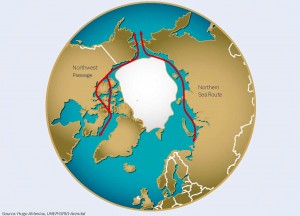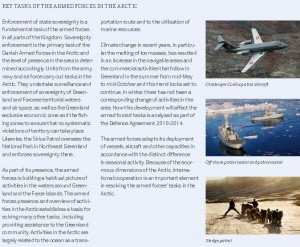12/13/2011 The Kingdom of Denmark has articulated a strategy for the Arctic. The Arctic is a key domain for the future of the Kingdom. Denmark is a member of the 5-member Arctic Council whose members control 80% of the known Arctic resources within their EEZs.
The strategy can be found here:
http://uk.nanoq.gl/~/media/29cf0c2543b344ed901646a228c5bee8.ashx
The Kingdom is a combination of Denmark and its autonomous regions, Greenland and the Faroe Islands. As a group, the region is sitting on a formidable treasure house and ecologically dynamic region.
Denmark is not a member of the Euro and as such the Danish currency can become more formidable over time as the resources are mined, processed and transported to the world’s markets.
In a companion piece, Admiral Nils Wang, Commandant of the Royal Danish Defence College and former head of the Danish Navy discussed the challenges of Arctic security. SLD has published several key pieces on the Arctic and we see the Arctic challenges as crucial in the decade ahead. It is a clear element of the significantly different post-Afghanistan security environment.
https://www.sldinfo.com/a-danish-perspective-on-the-challenge-of-arctic-security/
The preface to the document lays out the basic perspective underlying the strategy.
The Kingdom of Denmark is centrally located in the Arctic. The three parts of the Realm – Denmark, Greenland and the Faroe Islands – share a number of values and interests and all have a responsibility in and for the Arctic region. The Arctic makes up an essential part of the common cultural heritage, and is home to part of the Kingdom’s population.
The Kingdom and its populations have over several hundred years developed modern and sustainable societies based on democratic principles. The development has affected all sectors of society – from education, health and research to the environment, trade and shipping. At the same time, huge and sweeping changes are taking place today in the Arctic. Due to climate change and technological developments, vast economic potential is becoming more accessible
It is our common objective that the Arctic and its current potential must be developed to promote sustainable growth and social sustainability. This development must take place firstly to the benefit of the inhabitants of the Arctic and go hand in hand in safeguarding the Arctic’s environment.
With new opportunities come new challenges. The Arctic has to be managed internationally on the basis of international principles of law to ensure a peaceful, secure and collaborative Arctic. The purpose of this strategy is, on the basis of an already strong engagement in the Arctic, to reinforce the foundation for appropriate cooperation on the many new opportunities and challenges that the Arctic is facing.
The Kingdom is already a vigorous and important actor in the strategically vital international cooperation on the future of the Arctic and in that connection attaches great importance to creating transparency in and understanding for cooperation.
In the Kingdom’s strategy for the Arctic 2011- 2020, the Government, the Government of the Faroes and the Government of Greenland have set out the most important opportunities and challenges as we see them today and in the near future. On that basis we have defined our common political objectives for the Arctic.
The strategy discusses the impact of the new shipping lanes as a key part of the challenge of providing for maritime safety and security as well as search and rescue requirements. “The possibility of navigating the Northern Sea Route via the Northeast Passage will reduce the distance between Rotterdam and Yokohama by over 40% compared to the route via the Suez Canal.” (page 19).

The strategy articulates the need to exercise sovereignty and surveillance in the Arctic to defend the Kingdom’s interests.
The long-term political agreement on defence (Danish Defence agreement
2010-2014) involves a stronger focus on the tasks of the Danish Armed Forces in the Arctic. The agreement includes four overriding initiatives that must be viewed
light of climate change and increasedactivity that would foreseeably result in an increase of tasks for the armed forces.
Firstly, the Armed Forces North Atlantic command structure will be streamlined by the amalgamation of the Greenland Command and the Faroe Command into a joint service Arctic Command.
Secondly, the ability of the armed forces to conduct operations in the Arctic environment will be strengthened through the establishment of an Arctic Response
Force. The response force would not be established permanently, but designated from existing armed forces and emergency preparedness units with Arctic capacity or the potential to develop one.
The range of tasks of the Arctic Response Force is for defined periods and in defined areas anticipated to strengthen the armed forces’ enforcement of sovereignty and surveillance, for instance through military exercises. The force could also be deployed in other situations such as in assistance to the Greenlandic society.
Thirdly, a risk analysis of the maritime environment in and around Greenland is to be conducted in the light of an anticipated expansion of traffic and activity in the Arctic.
Fourthly, towards 2014 a comprehensive analysis of the armed force’s future tasks in the Arctic is to be carried out, including opportunities and potential for closer cooperation with partner countries in the Arctic concerning surveillance and the like. In this connection it is to be examined whether the Thule Air Base may play a larger role in regard to the tasks performed in and around Greenland by the Danish Armed Forces in cooperation with other partner countries.

The Danish Defence aspires, as other public institutions, to reflect the surrounding community. Indeed, it is a Danish-Greenland hope that citizens of Greenland can be increasingly involved in the tasks of the armed forces and with that, participate in a wide range of training opportunities, whether they be basic training, civil/military specialist and management training programs or customized further education at all levels. The armed forces will thereby also greatly benefit from Greenland local knowledge.
The armed forces must be visibly present in and around Greenland and the Faroe Islands with regard to the enforcement of sovereignty and surveillance. The North Atlantic command structure is to be streamlined by the establishment of an Arctic Command and an Arctic Response Force is to be designated from existing units. (pages 20-21).
Thule airbase in Greenland could well become an important hub to support maritime safety and security as well as search and rescue in the region.
The melting of the polar icecap and the consequent increased activity in the
Arctic will lead to greater need for the presence of and entail more tasks for the armed forces in the area around northern and north-western Greenland. Under the defence agreement of 2010-2014, the armed forces is carrying out a streamlining of the North Atlantic operational command structure and in the course of the duration of the agreement it must be considered whether the Thule base may play a larger role in regard to the tasks of the armed forces in and around Greenland in cooperation with other partner countries.
Thule Air Base is, with its deep water port, airport and well-developed infrastructure (including tank and storage capacity, workshop, hospital, quarters, support and office facilities), a unique capability in the Arctic region north of the Arctic Circle.
There is thus already an existing opportunity to provide the logistical prerequisites for increased presence in the area around the northerly and north-westerly Greenland.
Furthermore, Thule Air Base has the potential to become a broader platform for supporting the collaborative intentions of the Illulisat Declaration of 2008 between the 5 coastal states in the Arctic Ocean. Collaboration on the logistical facilities in Thule could thus eventually include assignments and emergency preparedness in relation to the maritime environment, a base for exercises in connection to joint procedures such as search and rescue services, and also be a platform for joint research in the Arctic.
The strategy discusses the oil and gas activities, water transport prospects, critical minerals in the region, the key ecological stakes in the region, the challenge for fisheries from development, the challenge of providing for search and rescue, the opportunity to shape a new approach to sustainable development, etc.
To achieve mission success will require close cooperation among the Arctic 5 and managing effectively outside powers seeking entrance into the region. “Arctic 5 is an essential complementary regional forum for the coastal states of the Artic Ocean. And to optimize the safeguarding of interests, the Kingdom will upgrade bilateral cooperation and dialogue regarding the Arctic, both with established and new partners.” (page 49).

